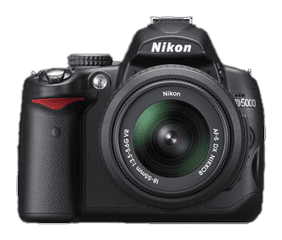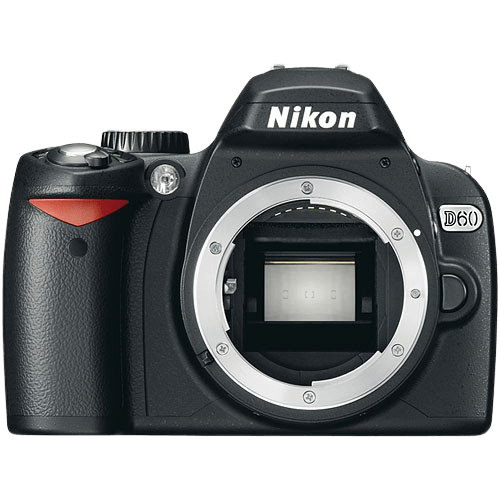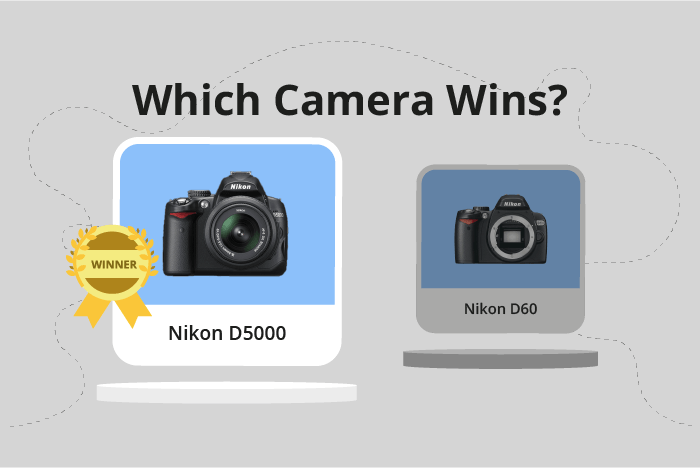Nikon D5000 vs D60 Comparison
Nikon D5000

Nikon D60

The Nikon D5000 outperforms the Nikon D60 with a score of 41/100 compared to the latter’s 34/100. Both cameras are DSLR models, released in 2009 and 2008 respectively. They share similarities in size, with the D5000 measuring 127 x 104 x 80mm and the D60 at 126 x 94 x 64mm.
The D5000’s higher score reflects its superior features, such as a later release date and a higher launch price of $730, compared to the D60’s $470. However, the D60 has its advantages, being lighter at 522g (1.15lbs) compared to the D5000’s 590g (1.30lbs).
Taking these specifications into account, the Nikon D5000 emerges as the better camera, while the Nikon D60 offers a more budget-friendly and lightweight option.
Nikon D5000 vs D60 Overview and Optics
The Nikon D5000 wins in the optics comparison with a score of 45/100, while the Nikon D60 scores 43/100. Both cameras share some common specifications, such as sensor size (APS-C), lens mount (Nikon F DX), and lack of image stabilization.
The D5000’s superiority is evident in its higher megapixel count (12.3), faster shooting speed (4), and better sensor type (CMOS). Additionally, the D5000 has a higher DXOMARK score for the sensor at 72, compared to the D60’s score of 65. These factors contribute to the D5000’s better image quality and performance.
Despite the D5000’s advantages, the D60 has its merits as well. Its 10.2-megapixel count is still sufficient for most photography needs, and it shares the same Expeed processor as the D5000. The D60’s CCD sensor type may be older technology, but it can still produce quality images. However, the D60 falls short in shooting speed, capturing only 3 frames per second compared to the D5000’s 4.
In comparing the optics of the Nikon D5000 and D60, it is clear that the D5000 is the superior camera. Its higher megapixel count, better sensor type, and faster shooting speed contribute to its higher score and overall better performance. While the D60 has some positive aspects, it does not surpass the D5000 in terms of optics.
Nikon D5000 vs D60 Video Performance
When comparing the video capabilities of the Nikon D5000 and the Nikon D60, it is important to note that the Nikon D60 does not have any video functionality. This means that if video recording is a priority for a user, the Nikon D60 would not be a suitable choice.
On the other hand, the Nikon D5000 offers video recording capabilities. With a video score of 49 out of 100, the camera provides standard HD video resolution. The maximum video dimensions are 1280 x 720, and it can record at a frame rate of 24fps. Additionally, the Nikon D5000 has built-in time-lapse functionality, which can be a useful feature for capturing events that occur over extended periods.
Taking these factors into account, the Nikon D5000 has video capabilities suitable for basic video recording needs, while the Nikon D60 does not offer any video functionality. Users should consider their specific needs and preferences when choosing between these two cameras, keeping in mind the video capabilities of each model.
Nikon D5000 vs D60 Features and Benefits
The Nikon D5000 outperforms the Nikon D60 with a feature score of 34/100, compared to the D60’s 17/100. Both cameras have similarities in their specifications, but the D5000 offers more advanced features that set it apart.
The D5000 and D60 share common specifications, such as a screen resolution of 230,000 dots, and the absence of a touchscreen, flip screen, GPS, WIFI, and Bluetooth. Despite these similarities, the D5000 boasts a larger screen size of 2.7 inches compared to the D60’s 2.5 inches.
The D5000’s higher feature score reflects its superior performance. The larger screen size enhances the user experience, making it more convenient to navigate through menus and review photos. This advantage gives the D5000 an edge over the D60.
On the other hand, the D60 has a lower feature score, which indicates that it may be lacking in certain aspects. However, this does not mean that the D60 has no advantages over the D5000. The D60’s smaller screen size may appeal to users who prefer a more compact and lighter camera, making it more portable and easier to carry around.
Considering these points, the Nikon D5000 stands out as the better camera in terms of features. The larger screen size provides a more enjoyable user experience, while the higher feature score proves its superiority. The Nikon D60, although lacking in some aspects, still offers value to users looking for a more compact option. Ultimately, the choice between the two cameras depends on individual preferences and priorities.
Nikon D5000 vs D60 Storage and Battery
The Nikon D5000 and Nikon D60 both have a storage and battery score of 27/100. They share common specifications, such as one memory card slot each, accepting SD and SDHC memory cards, and lacking USB charging capabilities.
The D5000 edges out the D60 in battery life, providing 510 shots compared to the D60’s 500 shots. This difference, though small, gives the D5000 a slight advantage. The D5000 also uses the EN-EL9a battery type, while the D60 uses the EN-EL9.
On the other hand, the D60 accepts an additional memory card format, MMC, which the D5000 does not. This feature could be beneficial for those with existing MMC cards.
Despite their equal scores, the Nikon D5000 has a minor advantage in battery life, while the Nikon D60 supports an extra memory card format. The choice between these cameras may depend on individual preferences and requirements in storage and battery aspects.
Nikon D5000 vs D60 – Our Verdict
Are you still undecided about which camera is right for you? Have a look at these popular comparisons that feature the Nikon D5000 or the Nikon D60:

